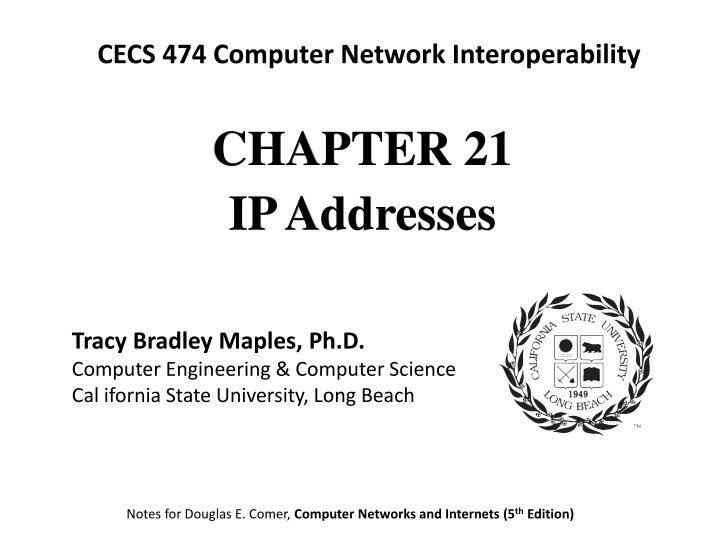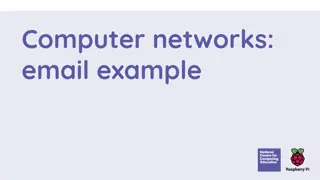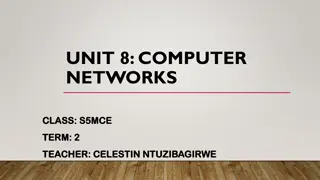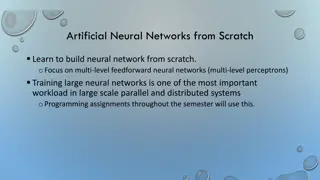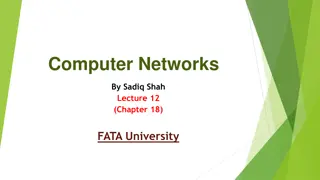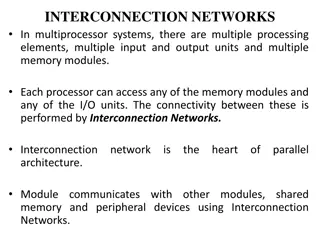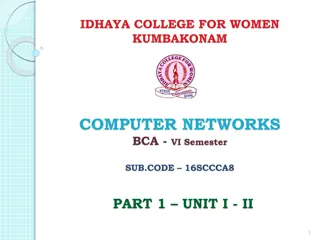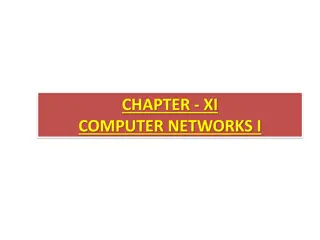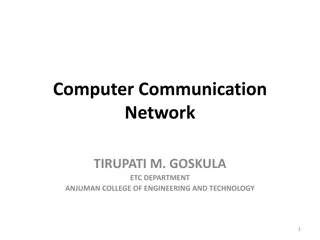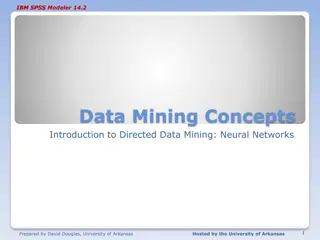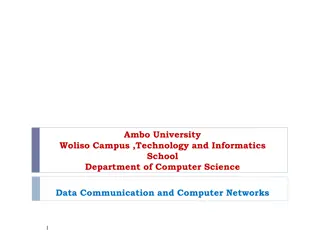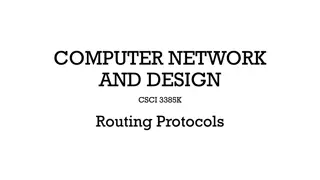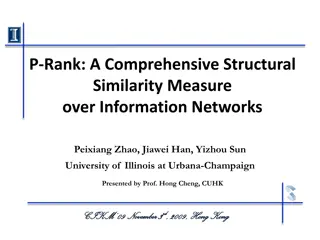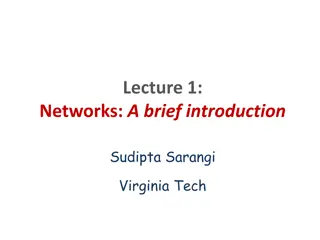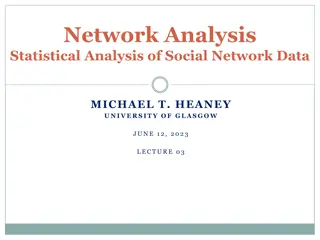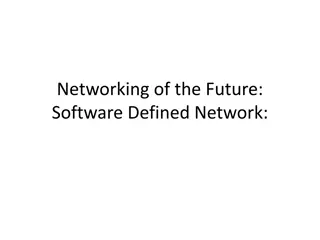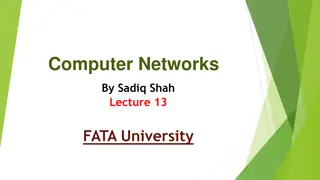IP Addressing in Computer Networks
IP addressing provides a seamless network for users by abstracting and providing a uniform addressing scheme used by higher-layer protocols and applications. IP addresses identify connections rather than specific computers, with IPv4 using 32-bit integers and IPv6 using 128-bit addresses. The division of IP addresses into prefix (network) and suffix (host) parts allows for unique addressing and local suffix assignment. Different classes of addresses determine network size, and the use of Dotted Decimal Notation simplifies representation for humans.
Download Presentation

Please find below an Image/Link to download the presentation.
The content on the website is provided AS IS for your information and personal use only. It may not be sold, licensed, or shared on other websites without obtaining consent from the author.If you encounter any issues during the download, it is possible that the publisher has removed the file from their server.
You are allowed to download the files provided on this website for personal or commercial use, subject to the condition that they are used lawfully. All files are the property of their respective owners.
The content on the website is provided AS IS for your information and personal use only. It may not be sold, licensed, or shared on other websites without obtaining consent from the author.
E N D
Presentation Transcript
CECS 474 Computer Network Interoperability CHAPTER 21 IP Addresses Tracy Bradley Maples, Ph.D. Computer Engineering & Computer Science Cal ifornia State University, Long Beach Notes for Douglas E. Comer, Computer Networks and Internets (5th Edition)
IP (Internet Protocol) Addressing IP addressing is an addressing scheme that provides the illusion of a large, seamless network for users. IP addressing is: an abstraction a uniform addressing scheme used by higher-layer protocols used by applications
IP (Internet Protocol) Addressing (Contd) An IP address does not identify a specific computer. Instead, each IP address identifies a connection between a computer and a network. A computer with multiple network connections (e.g., a router) must be assigned one IP address for each connection. IPv4 addresses are: Virtual (they are only understood by software) Used for all communication in TCP/IP 32-bit integers* Unique for each host *Note: IPv4 uses 32-bit IP addresses. IPv6 uses 128-bit IP addresses.
IP Address Details IP addresses are divided into two parts Prefix -- which identifies the network Prefix Suffix Suffix -- which identifies the host The Internet Assigned Number Authority is the global authority that has control over the assignment a unique prefix to each network. A local administrator assigns a unique suffix to each host. The IP hierarchy guarantees that: Each computer is assigned a unique address. Suffixes can be assigned locally without global coordination.
Original Classes of Addresses ? The initial bits determine the class of the address. The class determines the boundary between prefix and suffix.
Classes of Addresses (Contd) The maximum network size is determined by the class of the address: Class A -- large Class B -- medium Class C -- small ? ?
Dotted Decimal Notation octet = byte = 8-bits Dotted decimal notation is used: as shorthand for IP addresses. to let humans avoid binary numbers. Dotted decimal notation represents each octet in decimal separated by dots. (Note: This is not the same as domain names like www.csulb.edu.) For dotted decimal notation: There are four decimal values per 32-bit address. Each decimal number: -- Represents eight bits -- Has a value between 0 and 255 ?
ICANN Internet Corporation for Assigned Names and Numbers (ICANN) authority was established to handle: address assignment and adjudicate disputes ICANN does not assign individual prefixes. Instead, ICANN authorizes a set of registrars to assign prefixes. Registrars make blocks of addresses available to ISPs. ISPs provide addresses to subscribers. To obtain a prefix a corporation usually contacts an ISP.
Subnets and Classless Addressing As the Internet has grown, the original classful addressing scheme became a limitation. => Everyone wanted a class A or class B address. Two mechanisms were invented to overcome the limitation: Subnet addressing Classless addressing The two mechanisms are closely related and can be considered to be part of a single abstraction. Main concept: Instead of having three distinct address classes (Class A, B & C), allow the division between prefix/suffix to occur on an arbitrary bit boundary.
Subnets and Classless Addressing (contd) Example: Consider an ISP that hands out prefixes and a customer of the ISP that requests a prefix for a network that contains 55 hosts. Classful addressing, would require a complete class C prefix. 8-bits of suffix = 256 possible values = 0..255 Note: We do not use 0 (0000 0000) or 255 (1111 1111) for hosts So Class C gives us 254 possible addresses. that means 199 of the 254 possible suffixes would never be assigned most of the class C address space is wasted With Classless addressing, the ISP can assign: a prefix that is 26 bits long a suffix that is 6 bits long 6-bits of suffix = 26 possible values = 64 (minus 0 and 255) = 62 addresses
Subnets and Classless Addressing (contd) This figures illustrates the way classless addressing can be used by an ISP to divide a class C prefix into four (4) longer prefixes: each one can accommodate a network of up to 62 hosts the host portion of each prefix is shown in gray ?
Address (or Subnet ) Masks The classless and subnet addressing schemes require hosts and routers to store an additional piece of information: a value that specifies the exact boundary between the network prefix and the host suffix. To mark the boundary, IPv4 uses a 32-bit value known as an address mask, also called a subnet mask. Why store the boundary size as a bit mask? Hosts and routers need to compare the network prefix portion of the address to a value in their forwarding tables. The bit-mask representation makes the comparison efficient by making bitwise operations.
Address (or Subnet ) Masks (contd) Subnetting Example 1: Consider the following 32-bit network prefix: 10000000 00001010 00000000 00000000 = 128.10.0.0 Consider a 32-bit mask: 11111111 11111111 00000000 00000000 = 255.255.0.0 Consider a 32-bit destination address on the network which has address: 10000000 00001010 00000010 00000011 = 128.10.2.3 A logical AND (&) between the destination address and the address mask extracts the high-order 16-bits: 10000000 00001010 00000000 00000000 = 128.10.0.0
Classless Inter-Domain Routing (CIDR) The general form of CIDR notation is: ddd.ddd.ddd.ddd/m ddd is the decimal value for an octet of the address m is the number of one bits in the mask Consider the mask needed for a network with 28 bits of prefix: It has 28-bits of 1s followed by 4-bits of 0s In dotted decimal, the mask is: 255.255.255.240 In CIDR notation, the mask is written: 128.211.0.16/28 which specifies a mask with 28 bits of prefix and 4 bits of suffix. ?
Figure 21.5 A list of address masks in CIDR notation and in dotted decimal ?
Subnet Masks (Contd) The Mask field in a routing table is used to extract the network part of an address during lookup. A bit mask makes prefix extraction efficient, using Boolean AND. Example 2: A datagram is destined for 192.4.10.3 If 192.4.10.3 is a class C* network, the subnet mask will be 255.255.255.0. 192.4.10.3 & 255.255.255.0 = 192.4.10.0 * Why is 192.4.10.3 considered a class C network? (Hint: see previous slide.)
Illustration of Router Addresses ? The address prefix identifies the network. Need one router address per connection.
Special IP Addresses ? NOTE: The network address never appears in a packet. A loopback address never leaves the local computer.
